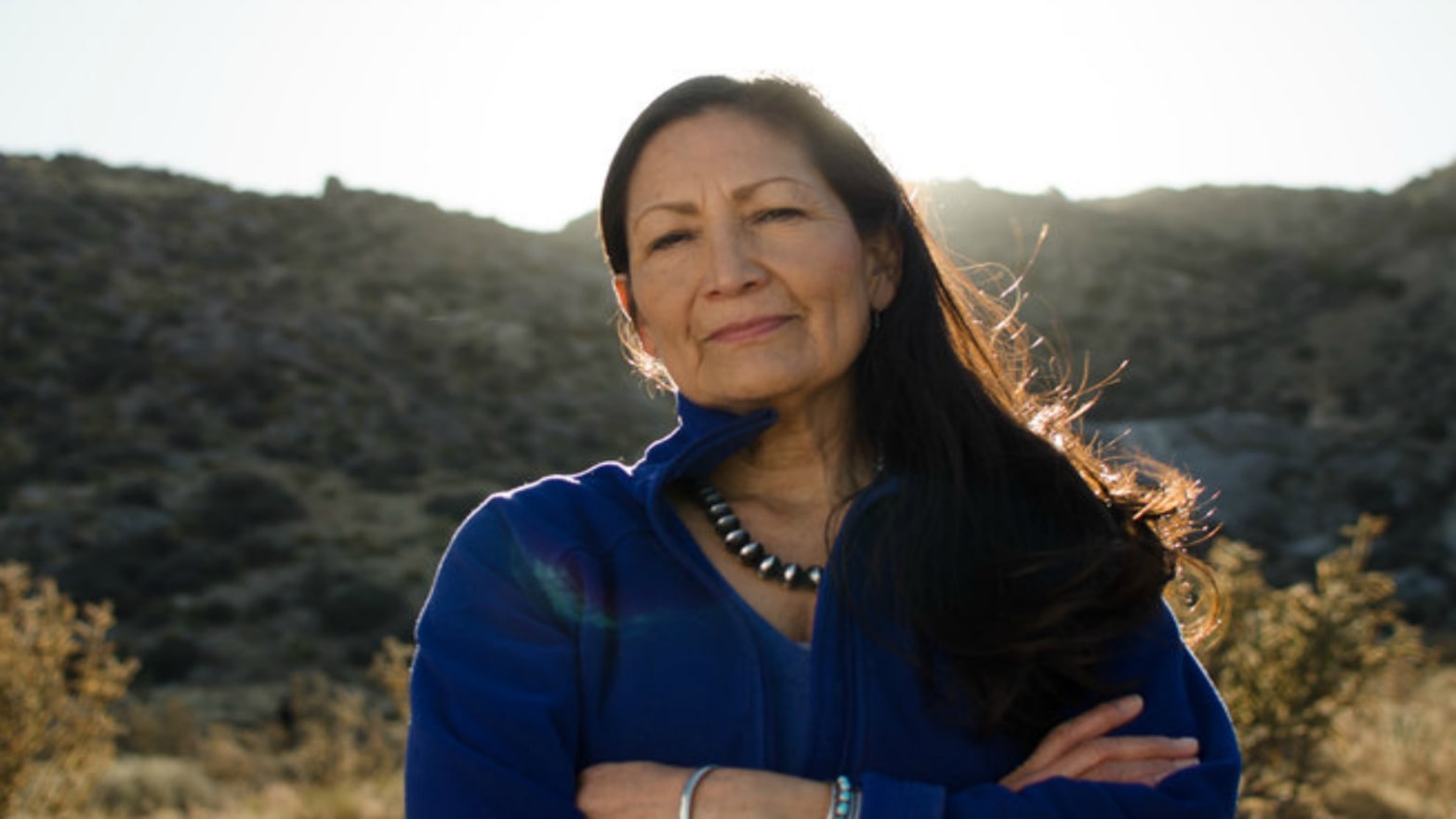While the chaos and drama of California’s sprawling primaries was not even close to being resolved early Wednesday morning, there was a surge of women across America securing their places on the ballot for November’s elections.
Kristi Noem became the first woman selected by Republican voters to stand for governor in South Dakota, where she is likely to win in November and make her the state’s first female governor.
In Iowa, Democratic women came to the fore: Cindy Axne, a small-business owner, comfortably beat out a challenge from the Sen. Bernie Sanders-endorsed Pete D’Alessandro; Abby Finkenauer, a state representative, was chosen to contest the 1st District at the age of just 28—she would become the youngest woman elected in Congress if she defeats the Republican incumbent in November.
Deb Haarland won the Democratic primary in New Mexico’s 1st Congressional District, putting her on track to become the first Native American woman in Congress after the incumbent, Michelle Lujan Grisham, stepped aside to contest—and win—the Democratic primary for governor.
One of the rare clear results from California saw the race for governor narrowed to Gavin Newsom, the former Democratic mayor of San Francisco and current lieutenant governor, against John Cox, a Republican businessman supported by President Trump. Cox remains a long-shot, but his success in securing a slot on the statewide ballot in November may help to pep up Republican voter enthusiasm in districts where incumbents such as Kevin McCarthy, the House majority leader, and Rep. Dana Rohrabacher, known as Vladimir Putin’s favorite congressman, are battling to hold on to their seats.
For weeks, the Democratic and Republican parties have pumped money into key California districts seen as monumentally important to control of Congress in November’s midterm elections. While the state has been on the forefront of nationwide liberal resistance to Donald Trump’s administration, the unique political structure of its primaries has led to concern that Democrats could be locked out of competing.
That’s because California has a top-two primary system in which the two candidates, regardless of party, with the most votes advance to the general election. And in a host of traditionally Republican-leaning districts where Democratic enthusiasm is at its highest, there are just too many Democratic candidates on the ballot—including the names of some who actually dropped out of their races.
By Wednesday morning, it appeared that Democrats had avoided the worst possible scenario in two of these districts. In California’s 49th District, represented by retiring Republican Darrell Issa (R-CA), early returns indicated that at least one Democrat, Mike Levin, would be advancing to the November election. Republican Diane Harkey leads in the district with Levin in second and Democrat Sara Jacobs in close third. The DCCC invested pretty heavily against Republican state assemblyman Rocky Chavez, which seems to have paid off as he is currently a distant sixth in the race.
Of greatest concern for the Democratic Party had been California’s 48th District represented by Rohrabacher. With vote counts continuing, it appeared that one of the two Democrats, Hans Keirstead or the Democratic Congressional Campaign Committee-backed Harley Rouda, would take second place. The two are almost dead-even in the second and third spots. A lot of the investment here had been directed against Republican candidate Scott Baugh, who currently sits at fourth place.
Similarly, the fight in California’s 39th District, represented by retiring Republican Rep. Ed Royce, is unresolved. The DCCC has backed Navy veteran and lottery winner Gil Cisneros, who has been in an at-times-contentious primary battle with Democrat Andy Thorburn. Cisneros has a clear lead against another Republican candidate, Phil Liberatore, and is likely going to face off against Republican Young Kim in November.
Yet there remains a lockout risk in another district that got less attention. In California’s 10th Congressional District, represented by incumbent Rep. Jeff Denham (R-CA), Democrat Josh Harder is clinging to a narrow second place ahead of Republican Ted Howze. This is another district where Hillary Clinton won in 2016, and one where Democrats are hoping to flip the seat.
Early on in the night, it became clear that the full results might not be known on Wednesday or, even in some cases, later on in the week. More than 118,000 voters were left off the voting roster in Los Angeles County, meaning that there will likely be more provisional ballots and all the results could take longer to come in.
While California and its unending drama captured all the attention leading into Tuesday’s mega primary day, seven other states voted across the country for candidates up and down the ballot. The results hold keys to both parties’ prospects in November’s midterm elections as Democrats remain bullish on their odds of capturing a majority in the House of Representatives even as some generic ballot polling indicates a much closer contest at this stage.
New Jersey: The Garden State could provide as many opportunities for Democrats as California, with five potentially competitive races against incumbent Republicans or open-seat contests. In New Jersey’s 2nd Congressional District, the DCCC sees an excellent opportunity to elect a Democrat to replace Republican Rep. Frank LoBiondo. Jeff Van Drew beat out a number of more progressive candidates to compete in the district that voted for President Obama twice.
New Jersey’s 3rd Congressional District, currently represented by Rep. Tom MacArthur, is a tougher challenge, but one where Democrats think their candidate can make it a race. MacArthur has been the subject of intense progressive ire for both authoring a crucial amendment to the Republican Affordable Care Act repeal legislation and for being the only member of the New Jersey congressional delegation to vote for the tax-overhaul legislation. Democrat Andy Kim, a national-security expert who has served in multiple presidential administrations, will face off against MacArthur in the district that encompasses parts of the Philadelphia suburbs.
The 7th District, one that Hillary Clinton narrowly won in the 2016 presidential election, is another pickup opportunity. Rep. Leonard Lance will face off there against Democrat Tom Malinowksi, a former assistant secretary of state.
New Jersey’s 11th District is now open as well, with Rep. Rodney Frelinghuysen retiring after 24 years of serving. Democrats are hopeful that attorney and Navy veteran Mikie Sherrill could pick up the seat.
Throughout the state, candidates backed by the DCCC, and added to its “Red to Blue” program that provides additional resources, won their primaries.
“New Jersey voters are disgusted with a Republican agenda that hurts the Garden State, and are ready for change and new leadership,” a spokesperson for the DCCC said Tuesday night. “With unprecedented grassroots energy and our strong and dynamic candidates, New Jersey will play a significant role in the DCCC’s effort to take back the House.”
Iowa: While President Obama won the state twice, it swung fairly dramatically in favor of Trump in 2016, raising the stakes for Democrats to make inroads here.
They see hope in Iowa’s 1st Congressional District, where Rep. Rod Blum has been ensconced in scandal. The young State Rep. Abby Finkenauer, who is backed by labor unions in the state, could prove to be a tough challenger against Blum in November.
New Mexico: Democrats have been excited about the prospects of making further gains in the Southwest, particularly in New Mexico’s open 2nd Congressional District. Rep. Steve Pearce (R-NM) vacated the seat to run for governor in the state, in a contest that Cook Political Report recently moved into Democrats’ favor. Xochitl Torres Small, a Las Cruces water attorney, emerged from the primary and will face off against State Rep. Yvette Herrell.
The national party is also hoping to elect a Democrat for governor as well, with U.S. Rep. Michelle Lujan Grisham seen as a likely favorite to replace retiring Republican Gov. Susana Martinez.
Alabama: On the Republican side, one race proved that fealty to President Trump might be the most important factor in GOP primaries. Incumbent Rep. Martha Roby, who said she would not vote for Trump after the Access Hollywood tape came out, did not clear 40 percent of the vote in her primary tonight, meaning that she will have to face a runoff in July. Her challenger is Bobby Bright, a former Democratic member who Roby defeated eight years ago.
UPDATE: This story has been updated to include more results from California.

